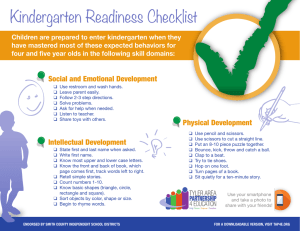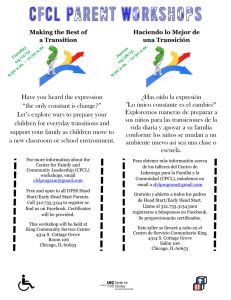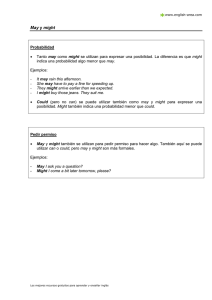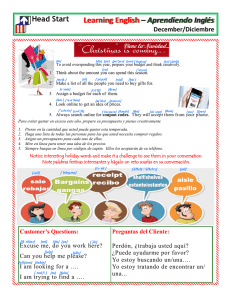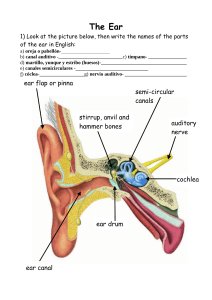PE771S Ear Splinting - Spanish
Anuncio
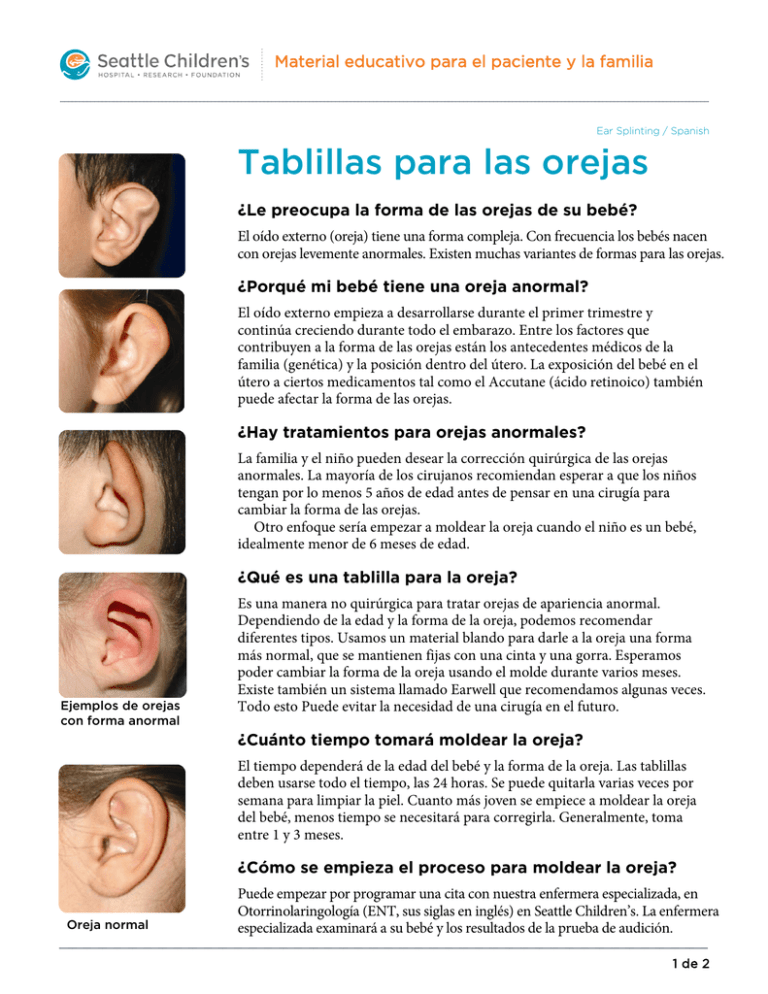
Material educativo para el paciente y la familia Ear Splinting / Spanish Tablillas para las orejas ¿Le preocupa la forma de las orejas de su bebé? El oído externo (oreja) tiene una forma compleja. Con frecuencia los bebés nacen con orejas levemente anormales. Existen muchas variantes de formas para las orejas. ¿Porqué mi bebé tiene una oreja anormal? El oído externo empieza a desarrollarse durante el primer trimestre y continúa creciendo durante todo el embarazo. Entre los factores que contribuyen a la forma de las orejas están los antecedentes médicos de la familia (genética) y la posición dentro del útero. La exposición del bebé en el útero a ciertos medicamentos tal como el Accutane (ácido retinoico) también puede afectar la forma de las orejas. ¿Hay tratamientos para orejas anormales? La familia y el niño pueden desear la corrección quirúrgica de las orejas anormales. La mayoría de los cirujanos recomiendan esperar a que los niños tengan por lo menos 5 años de edad antes de pensar en una cirugía para cambiar la forma de las orejas. Otro enfoque sería empezar a moldear la oreja cuando el niño es un bebé, idealmente menor de 6 meses de edad. ¿Qué es una tablilla para la oreja? Ejemplos de orejas con forma anormal Es una manera no quirúrgica para tratar orejas de apariencia anormal. Dependiendo de la edad y la forma de la oreja, podemos recomendar diferentes tipos. Usamos un material blando para darle a la oreja una forma más normal, que se mantienen fijas con una cinta y una gorra. Esperamos poder cambiar la forma de la oreja usando el molde durante varios meses. Existe también un sistema llamado Earwell que recomendamos algunas veces. Todo esto Puede evitar la necesidad de una cirugía en el futuro. ¿Cuánto tiempo tomará moldear la oreja? El tiempo dependerá de la edad del bebé y la forma de la oreja. Las tablillas deben usarse todo el tiempo, las 24 horas. Se puede quitarla varias veces por semana para limpiar la piel. Cuanto más joven se empiece a moldear la oreja del bebé, menos tiempo se necesitará para corregirla. Generalmente, toma entre 1 y 3 meses. ¿Cómo se empieza el proceso para moldear la oreja? Oreja normal Puede empezar por programar una cita con nuestra enfermera especializada, en Otorrinolaringología (ENT, sus siglas en inglés) en Seattle Children’s. La enfermera especializada examinará a su bebé y los resultados de la prueba de audición. 1 de 2 Tablillas para las orejas Para más información • Otorrinolaringología 206-987-2105 • El proveedor de atención médica de su niño • www.seattlechildrens.org Servicio gratuito de interpretación • Dentro del hospital, solicítelo con la enfermera de su niño. En esa cita también le haremos el molde y le enseñaremos cómo debe mantenerse colocado en la oreja. Otra cita en una o dos semanas y una vez al mes a partir de esa cita hasta que el molde ya no sea necesario. Cuando el bebé tenga entre 2 y 3 años, se programará una cita con el doctor para una evaluación y una prueba de audición. ¿Moldear la oreja tiene algún riesgo? El molde de la oreja puede irritar la piel; para eso, quitándolo cada 2 o 3 días para limpiarlo ayuda a minimizar las molestias. Durante las citas revisaremos si hay irritación en la piel. El mayor riesgo es que la apariencia de la oreja no mejore. ¿Dónde puedo obtener más información sobre tablillas para orejas? La consulta inicial y siguientes citas serán en Otorrinolaringología de Seattle Children’s. Puede pedir una cita llamando al 206-987-2105. • Fuera del hospital, llame a nuestra línea gratis de interpretación telefónica 1-866-583-1527. Menciónele al intérprete el nombre de la persona o extensión que necesita. Seattle Children's ofrece servicio de interpretación gratuito para los pacientes, sus familiares y representantes legales sordos, con problemas de audición o con inglés limitado. Seattle Children's tendrá disponible esta información en formatos alternativos bajo solicitud. Por favor llame al Centro de Recursos para Familias al 206-987-2201. Este volante ha sido revisado por personal clínico de Seattle Children's. Sin embargo, como las necesidades de su niño son únicas, antes de actuar o depender de esta información, por favor consulte con el médico de su hijo. © 2008, 2010, 2013, 2015 Seattle Children’s, Seattle, Washington. Todos los derechos reservados. Otorrinolaringología 10/15 Rev (jw/) PE771 S 2 de 2 Patient and Family Education Ear Splinting Are you concerned about the shape of your baby’s ear? The outer ear is a complicated shape. Babies are commonly born with mildly abnormal ears. There is a wide range of ear shapes. Why does my baby have an abnormal ear? The outer ear starts to develop during the first trimester and continues to grow throughout the pregnancy. Factors that contribute to the shape of the ears include family history (genetics) and positioning within the uterus. In utero exposure to certain medications, such as Accutane (retinoic acid) may also affect the shape of the ear. Are there any treatments for abnormal ears? Families and children may seek surgical correction of abnormally shaped ears. Most surgeons recommend waiting until the child is at least 5 years old before performing surgery to change the shape of the ear. Another approach is to start ear splinting when your child is a baby, ideally less than 6 weeks old. What is ear splinting? Ear splinting is a non-surgical way to treat abnormally shaped ears. Depending upon the baby’s age and the shape of the ear we may recommend different types of splinting. We use a soft material to mold the ear into a more normal shape. It will then be secured using tape and a hat. We hope to permanently change the shape of the ear by maintaining the new shape for several months. There is also an ear splinting system called Earwell that we sometimes recommend. This may avoid the need for surgery in the future. Examples of abnormally shaped ears How long does ear splinting take? The length of time depends on your baby’s age and shape of the ear. Ear splints should be worn at all times, 24 hours a day. You can remove the splints several times a week to clean your baby’s skin. The younger your baby is when ear splinting is started the shorter amount of time that is needed to correct the ear shape. Usually, it will take 1 to 3 months. How do we start ear splinting? You and your baby can schedule a visit with our nurse practitioner, in the Otolaryngology (ENT) Clinic at Seattle Children’s Hospital. The nurse practioner will examine your baby and review the results of their hearing screening. Normal ear 1 of 2 Ear Splinting To Learn More • Otolaryngology Clinic 206-987-2105 • Ask your child’s nurse or doctor • www.seattlechildrens.org Free Interpreter Services • In the hospital, ask your child’s nurse. • From outside the hospital, call the toll-free Family Interpreting Line 1-866-583-1527. Tell the interpreter the name or extension you need. At that visit, we will also create the splint and teach you how to keep the ear splinted. A follow-up appointment will be made 1 to 2 weeks later and then about once a month until splinting is no longer needed. When your baby is 2 to 3 years old, they will be scheduled to see the doctor for an evaluation and hearing test. Are there any risks to ear splinting? Ear splinting can irritate the skin. Remove the splint every 2 to 3 days to clean it. This can help reduce discomfort. We will look for skin reactions at your child’s follow-up visits. The major risk is that it may not improve how your child’s ear looks. Where can I get more information on ear splinting? Initial consultation as well as all follow-up visits will be done in the Otolaryngology Clinic at Children’s. You can make an appointment by calling the Scheduling Center at 206-987-2105. Seattle Children’s offers interpreter services for Deaf, hard of hearing or non-English speaking patients, family members and legal representatives free of charge. Seattle Children’s will make this information available in alternate formats upon request. Call the Family Resource Center at 206-987-2201. This handout has been reviewed by clinical staff at Seattle Children’s. However, your child’s needs are unique. Before you act or rely upon this information, please talk with your child’s healthcare provider. © 2008, 2010, 2013, 2015 Seattle Children’s, Seattle, Washington. All rights reserved. 10/15 PE771 2 of 2


